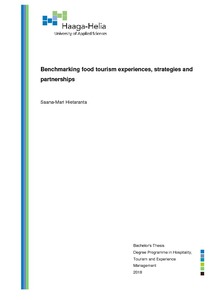Benchmarking food tourism experiences, strategies and partnerships
Hietaranta, Saana-Mari (2018)
Hietaranta, Saana-Mari
Haaga-Helia ammattikorkeakoulu
2018
All rights reserved
Julkaisun pysyvä osoite on
https://urn.fi/URN:NBN:fi:amk-201805097460
https://urn.fi/URN:NBN:fi:amk-201805097460
Tiivistelmä
This thesis looks at the food tourism industry from the development areas of experiences, strategies and partnerships. The objective is to find out what destinations have been doing to develop these and what kind of examples they have from these. This is done to assess where Finland’s food tourism development stands on an international level and what could be learned and adapted. The research is done for the Finnish FOOD & TOURISM project, whose work is presented in the theoretical framework along with an overall description of the food tourism industry in Finland.
The theoretical framework starts with an overview of the food tourism industry. The main concepts and issues are explained, and the main stakeholders are presented. There are more in-depth sections describing the consumers of food tourism, as well as the marketing side of the industry. After these, the theory of the main research areas, namely experiences, strategies and partnerships are discussed.
The research method used in this thesis is benchmarking. The method and how it works are introduced in the empirical part. Besides the main focus areas, the research was narrowed to material provided in English and to examples from destinations that indicated development and supply in food tourism and thus provide competition and future learning perspectives for Finland. The research data was collected mostly from online sources that were destinations’ websites, publications and articles.
The findings of the research present various types of food tourism products and experiences from different categories. These include restaurants, food festivals and markets, food tours and trails, food attractions and cooking classes. The strategy findings show that the Finnish food tourism strategy has a lot of similarities with the mentioned international counterparts. The research also indicates that there are currently not too many strategies dedicated solely for food tourism, at least not publicly available. However, it was found out that some destinations have initiatives for these. The examples from the partnerships indicate various types of networks in different food tourism development areas, such as consulting and advice, funding, marketing, media and quality assurance. These showcase the possibilities for different industry partnerships and prospects for development.
As a conclusion, the objective for the research was met by presenting various international examples and findings from the research areas. These were benchmarked to the Finnish examples, with a discussion on how these could contribute to Finland’s food tourism development. There are also suggestions for other benchmarking research areas in the future.
The theoretical framework starts with an overview of the food tourism industry. The main concepts and issues are explained, and the main stakeholders are presented. There are more in-depth sections describing the consumers of food tourism, as well as the marketing side of the industry. After these, the theory of the main research areas, namely experiences, strategies and partnerships are discussed.
The research method used in this thesis is benchmarking. The method and how it works are introduced in the empirical part. Besides the main focus areas, the research was narrowed to material provided in English and to examples from destinations that indicated development and supply in food tourism and thus provide competition and future learning perspectives for Finland. The research data was collected mostly from online sources that were destinations’ websites, publications and articles.
The findings of the research present various types of food tourism products and experiences from different categories. These include restaurants, food festivals and markets, food tours and trails, food attractions and cooking classes. The strategy findings show that the Finnish food tourism strategy has a lot of similarities with the mentioned international counterparts. The research also indicates that there are currently not too many strategies dedicated solely for food tourism, at least not publicly available. However, it was found out that some destinations have initiatives for these. The examples from the partnerships indicate various types of networks in different food tourism development areas, such as consulting and advice, funding, marketing, media and quality assurance. These showcase the possibilities for different industry partnerships and prospects for development.
As a conclusion, the objective for the research was met by presenting various international examples and findings from the research areas. These were benchmarked to the Finnish examples, with a discussion on how these could contribute to Finland’s food tourism development. There are also suggestions for other benchmarking research areas in the future.
